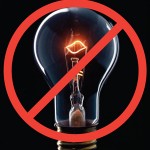Put People to Work Replacing all Residential Incandescent Lighting with Compact Fluorescent Lighting
What happens if we use “shovel ready” federal stimulus funds for energy infrastructure improvement to pay a professional to come to your house and change out your incandescent lighting with compact fluorescent lighting (CFL) before the end of 2010? How much energy would the state save? Could we put off building new power plants? How much money would you, the homeowner, save on your electric bill? How much would it cost to replace all of Florida’s light bulbs? How many jobs would be created? How much green house gases would be eliminated?

An incandescent light bulb is only about 4% efficient (96% of the electricity makes heat), so not only does such lighting gobble electricity for lighting, but it creates heat as a by-product, which must be removed by air conditioners in Florida. Replacing incandescent lights bulbs provides 75% electric savings on lighting electric use plus an additional electricity savings of 24% for less air conditioning. Because of this large energy use, incandescent lighting may soon be banned in many parts of the world. The current plans for bans on incandescent sales are: Australia (2010), New Zealand (2010), Netherlands (2011), Canada (2010), European Union (2012), United States (2014), California (2010), Connecticut (2012), New Jersey (2012).
Florida could join the other locations that aim to ban the incandescent lamp or we could use “shovel” ready resources for energy infrastructure improvement to put workers back to work, lower our monthly electric bills, make our air and water cleaner, reduce global warming and keep Florida’s wealth and workers in Florida – all before the end of 2010 and we’d be ahead of the bans!
The typical Florida single housing has approximately 40 lamps. By changing incandescent lighting to CFL, the average home will save $245 per year over the 10-year lifetime of the CFL. This equates to a statewide cost savings of $2.1 billion per year from Florida’s 8.5 million existing housing units (2006). The energy saved by this transition would also reduce Florida’s energy capacity by more than what we would get from a 1000MW nuclear power plant. [CFL savings calculation (Excel)]

Now what would the improvements cost? While many CFLs are now $2 each, one pays a premium for recessed and vanity bulbs and three way fixtures, etc., so to be conservative we estimate $4 per bulb (this is really generous – a lighting retrofit operation with high volume prices could be 30% lower). So the cost of bulbs per housing unit is then, 40 x $4 = $160. The installs would be done by two professionals per housing unit, two hours to do a housing unit from top to bottom at $35/hr plus $50 for travel, profit and overhead for a labor cost of $190. The total cost per home is then $350 with a simple payback of 1.4 years. The statewide cost would be $2.96 billion for the 8.5 million housing units. For 4 person hrs per house times 8.5 million housing units divided by 40 hrs/week and then divided by 52 weeks/yr, one gets 16,350 professionals per year to complete the installation.
This is an ideal “shovel ready” project. The federal government could give Florida $2.96 billion, $350 for every housing unit in Florida , to change out light bulbs and each Florida home would save $245 per year over the ten year life of the CFLs, 16,350 job-yrs would be immediately created and Florida would not have to build at least one nuclear power plant.
The next shovel ready project would be to replace all the thermostats with programmable thermostats, then we upgrade your ducting and your insulation, we install a better air conditioner, and a solar hot water heater. How far can we play this energy efficiency approach? Let’s play all the way to a net zero energy home. Let us stop using shovels to dig ourselves deeper in debt and put the shovels and people to work making our homes energy efficient!
Jim Fenton
Director, Florida Solar Energy Cener
Excellent guidance on saving energy, reducing monthly bills, and creating new jobs.
About 2-weeks ago, I spent close to $300 to replace all my lightbulbs with CFL’s. I am anxious to see my next utility bill and future bills to see the real difference over the next 12 months.
Furthermore, I have scheduled a home energy audit with Progress Energy on April 21st. ( the earliest appointment they could give me on March 20th). Depending on the audit results and recommendations, and local, state and federal incentives, I would begin to implement some and may be all depending on finances.
And last but not the least, I am in preliminary discussions with a European manufacturer of PV’s for a full time sales, business development position.
Thank you for all the good work you are doing. Keep it up.
Sincerely,
M.Turkel
Dear Jim,
I briefly discussed the energy advantages of LEDs over incandescent lighting sources.
I reviewed your webpages:
http://www.fsec.ucf.edu/en/about/index.htm
https://blog.energyresearch.ucf.edu/category/directors-message/
Consider linking:
https://blog.energyresearch.ucf.edu/category/directors-message/
on the “About Us” page: http://www.fsec.ucf.edu/en/about/index.htm:, under the link title “Directors Message”.
Kudos!
Replace bulbs with CFLs is a great idea. I would like to see the big box retailers to start selling outdoor CFL flood lights in different colors. Many homes and properties have replaced their white lights but can’t find these bulbs in colors locally.
GREAT IDEA, but WRONG BULBS (lamps)! LEDs would be the way to go. Since we’re buying efficiency why not go to the top level with 1/5th the power (1/20 or greather than incandescent) of CFLs, no heat, and longer life (10 years +, 50,000 hours) and no trace mercury to dispose of.
The retrofits will last far longer with no enviornmental mercury results at disposal. This will also greatly bring down the cost of LEDs for all too!
We have bulbs for over 50 types of lamps and fixtures – most every light has a replacement now in 2009.
http://www.ecosmartinc.com/catled/catlite20.php
Director Fenton and I had this conversation about a month ago as he was writing this article for publication – again, I’ll suggest that it be sent to Charlie Christ in Tallahassee and onto the Obama people in D.C. as a very logical, and IMMEDIATE COMMON SENSE approach to getting started on a massive problem we are already into the late 4th quarter into as it is. So many people are out of work – let’s get some of them together, a “leisure army”, and send them out into their communities to do these swap-outs. Like some many others – I’m unemployed now, I’ll volunteer!
“Waste Anything, but TIME” CO2 is climbing like sales of RED INK to banks.
Time is a luxury we passed about 10 years ago in the CO2 war.